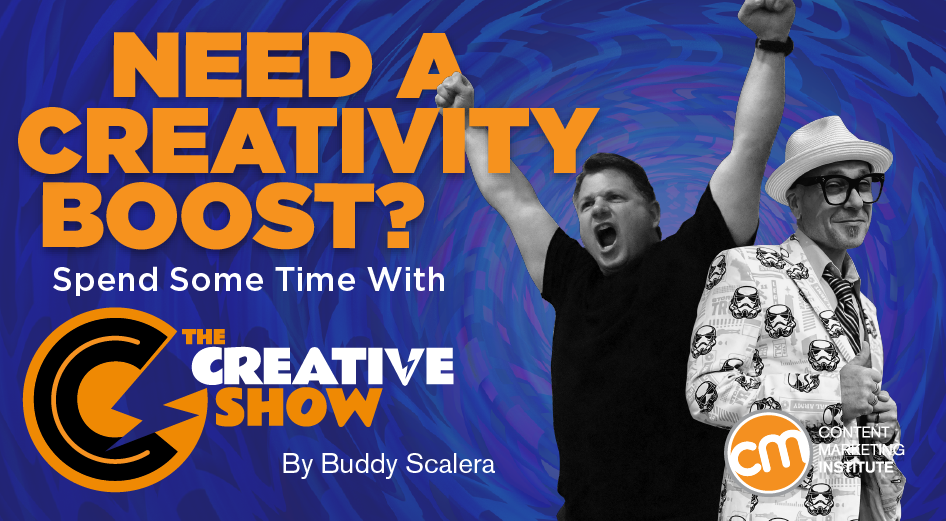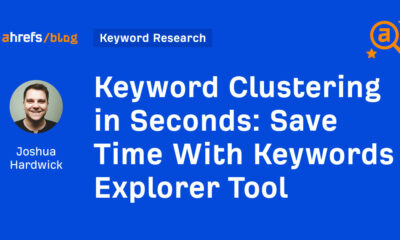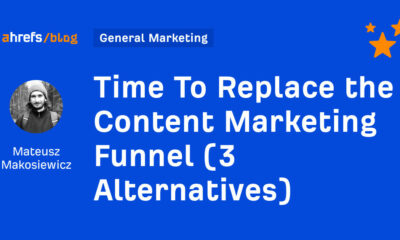MARKETING
Need a Creativity Boost? Spend Some Time With The Creative Show

CMI creative director Joseph Kalinowski contributed to this piece.
In just 10 episodes, CMI’s The Creative Show has completely rewritten the rules for live streaming, visual storytelling, and conversations about creativity.
Maybe we’re exaggerating a tiny bit. But we’re creatives, so we reserve the right for a bit of good-natured hyperbole about the impact of our show.
We’re excited for season two, which debuts at 2 p.m. (U.S. ET) Friday, Jan. 28, on Facebook, LinkedIn, and YouTube. If you haven’t caught every episode (or any episode), look back with us as we share some behind-the-scenes observations and highlights from our creative conversations in the first season.
Origin story
First, a little background: I met JK Kalinowski in 2012 at the Content Marketing World Health Summit. JK is CMI’s creative director. I’m a health-care content strategist by day and a comic book writer by night. We were destined to become fast friends.
FUN FACT: Our first conversation was about The Six Million Dollar Man TV show and toy line.
Over the years, we’ve written together for CMI, including:
In 2021, JK flew to New Jersey to participate in my Comic Book School panels at New York Comic-Con.
During the pandemic, JK approached me with the idea for a monthly 30-minute live show where we’d talk about creativity. The Creative Show was born. We started broadcasting – live from the deepest corners of the marketing internet, where no tactic goes uncovered, and every episode begins or ends (sometimes both) with Star Wars and Marvel Cinematic Universe trivia.
Every month, #TheCreativeShow streams 30 minutes to talk #creativity. Go behind the scenes of its debut year via @BuddyScalera @jkkalinowski @CMIContent. Click To Tweet
The Creative Show Season 1 Episode Guide
Use these show summaries and behind-the-scenes glimpses to decide which episodes to catch up on before joining us live for season two when we can read your comments in the live show.
Episode 1 – The Debut
Streamed live: Jan. 29, 2021
Engineer: Monina Wagner
Description: Monina interviews us to dig into the secret origins of our creative power and set the stage for the show.
Behind the scenes: We hadn’t quite mastered the art of the short answer, and the audio has a lot of bounce and echo. Despite a few switching glitches, we managed our way through live learning.
Content takeaway: Both JK and I talk about how almost everyone uses creative thinking in the way they approach their jobs. JK shares how his wife applies creativity in her job teaching children with special needs:
FUN FACT: JK once designed and produced a treasure map and sent it as a message in a bottle to Jimmy Buffet’s Margaritaville offices in hopes of landing the singer’s new alcohol line as a client for a Pennsylvania-based advertising agency. After sending messages in a bottle five weeks in a row, the agency finally scored a meeting with Jimmy’s manager.
Episode 2 – What Is the Greatest Movie Poster of All Time?
Streamed live: Feb. 26, 2021
Engineer: Monina Wagner
Description: We dive into the indisputable greatest movie poster of all time, breaking down why the visual promotion of JAWS is so iconic. We also look at less effective and exciting movie posters and discuss why they fail at differentiating in a noisy marketplace.
Behind the scenes: Our super-slick montage intro and our recurring What’s in the Box segment debut. (Spoiler: It’s Rolling Stones memorabilia in this episode). Spot a few clumsy moments as we try to figure out how to communicate with our engineer.
Content takeaways: Here’s a meta takeaway: We took repurposing content to the next level to give our livestream audience a new take on the Jaws movie poster that we wrote about in 2015.
The episode takeaway is how creators easily assume people are more familiar with your brand than they are. JK talks about the poster for the movie Joy and tells nothing about the movie except it stars Jennifer Lawrence. I liken this approach to a brand skipping an about page because they (incorrectly) assume everyone knows all about the brand. That approach fails people in the early part of their journey, where they’re looking for information. Follow our discussion here:
FUN FACT: JAWS is considered the first summer movie blockbuster.
Episode 3 – Marketers and Their Toys
Streamed live: March 26, 2021
Engineer: Monina Wagner
Description: Nurturing creativity means celebrating the spirit of play. We open up our toy boxes and talk about toy lines that benefitted from story-based content marketing.
Behind the scenes: We improve some of the production, including sound and engineering. And we repurpose more articles into this livestream experience, including:
It also gave us an excuse to talk about Star Wars, Marvel Comics, GI Joe, and He-Man. And JK shows off an issue of Vox Teen Beat from 1967 as an example of early content marketing.
Content takeaway: Hasbro created a content feast in the form of comic books to support GI Joe and taught kids how to play with the toys. That’s an important concept – marketers can use content to teach your base how to use your product. Here’s the clip, which includes lots of examples from my collection:
FUN FACT: Peter Jackson’s Get Back documentary shows The Beatles reading multiple versions of Beatles Fan Club magazines like Vox Teen Beat. (Bonus content: JK recently wrote about the creative lessons you can learn from the Get Back documentary.)
Episode 4 – That Sounds Creative
Streamed live: April 30, 2021
Engineer: Monina Wagner
Description: Impact of sound and music in videos and films – and how music helps you get into a creative groove. We share a couple of clips that show how music can change the tone of even familiar images:
Music can change the tone of even familiar images, says @BuddyScalera @jkkalinowski via @CMIContent. #Creativity #Storytelling Click To Tweet
Behind the scenes: Ironically, we discover we don’t know how to run sound just yet. Spot a few technical and linguistic challenges before we pull through in the end.
Content takeaway: Sound is its own language in cinema – and that translates over to marketing. Understanding that language is important to conveying your message. Here’s where we explore how that idea applies to explainer and other content marketing videos:
FUN FACT: Stanley Kubrick relied as heavily on music and sound as visual imagery for his horror classic The Shining.
Episode 5 – Designed to Work
Streamed live: May 28, 2021
Engineer: Monina Wagner
Description: Website design, general usability, and functional design of devices are discussed. We compare and contrast the Verizon and Roku remote controls. A little closer to home, JK explains how he creates the posters for Content Marketing World with thematic designs.
Behind the scenes: When I invited JK into the show … he doesn’t appear. (He had just lost power.) Quick-thinking Monina jumps into the conversation because, hey, we were live. Experiences like this help us prepare for future technical difficulties. We haven’t had another major glitch, but we have had a few minor ones that the audience probably didn’t even notice.
Content takeaway: Too often, design is considered ornamental, but it’s really a foundational element of any content project. That’s why the design team should be involved from the beginning.
FUN FACT: According to MRO Electric, Maine has the most power outages per year, with an average of 3.9 per customer each year.
#Design is a foundational element of any #content project. The design team should be involved from the beginning, says @BuddyScalera @jkkalinowski via @CMIContent. Click To Tweet
Episode 6 – Inside Creativity
Streamed live: June 25, 2021
Engineer: Monina Wagner
Description: Finding bright spots from this otherwise terrible global experience. Bo Burnham’s Inside special on Netflix is an entry point. I discuss my Comic Book School project. (Since that time, Comic Book School has won three awards, including a Content Marketing Award.)
Behind the scenes: We finally learned how to play a clip (with audio) exactly as we mean to – only to realize there’s an F-bomb in it that we didn’t warn the audience about. (Consider yourself warned.)
Content takeaway: The pandemic uprooted our usual ways of working. But Bo Burnham took the tools he had at hand (an iPhone, a camcorder, lights, microphones) and documented the moment. He showed how to use limitations to inspire new types of storytelling. You see him try and fail – and document the whole thing. The pandemic didn’t pause his creativity, and it doesn’t have to put a stop to ours. Here’s the segment I’m talking about:
FUN FACT: According to the US Bureau of Labor Statistics, leisure time increased by an average of 37 minutes per day for men and 27 minutes for women between May 2019 and December of 2020. This increase partly reflects a decline in average work time (as the share of employed people fell during the pandemic) and a decrease in the average time people spent traveling.
Episode 7 – The Creative Toolbox
Streamed live: August 27, 2021
Engineer: Amanda Subler
Description: We talk about the tools we use to create, including software, snazzy notebooks, an industrial T-square, a scaling wheel, and an X-Acto set from the old days of physical magazine layouts.
Behind the scenes: We welcome Amanda Subler as our new engineer. Though Amanda chose not to be on camera, she finds clever ways to interact with us during the show.
Creative takeaway: I share an unusually organized look at the tools I use in creating, delivering, analyzing, reporting, and collaborating. Here’s the clip where I show that and talk with JK about following a creative project all the way through these stages:
FUN FACT: Adobe Inc. got its name from the Adobe Creek that ran behind co-founder John Warnock’s home in Los Altos, Calif. His wife Marva designed Adobe’s stylized “A” logo.
Episode 8 – The Idea Etherverse
Streamed live: Oct. 1, 2021
Engineer: Amanda Subler
Description: We talk about The Idea Etherverse, a shared consciousness of ideas that we can all access. Existential? Sure, why not? More practically, we discuss capturing ideas on notebooks, scraps of paper, and even in voicemails, and other strategies for capturing, saving, and improving ideas that just come to you from the ether.
Behind the scenes: JK’s custom-made shirt featuring The Creative Show logo makes its debut.
Creative takeaway: Talking through an idea can help flesh it out. Just don’t be discouraged by the initial reaction. Take the input and give the idea more time to grow. JK and I talk about our experiences with that approach:
FUN FACT: Field Notes brand was co-founded by graphic designer Aaron Draplin, who was inspired by promotional memo books given to farmers by seed and agricultural companies over the past century. JK grew up on a farm and received several memo books from his local farm co-op.
Episode 9 – The Iron Maiden of Marketing
Recorded Oct. 2, 2021
Engineer: Amanda Subler
Description: We explore the band Iron Maiden’s incredible career as an example of audience- and community-building. JK and I share the albums that we loved as teens but would have been embarrassed to share without friends. Today, we share them with pride.
Behind the scenes: This and the 10th episodes were recorded. We planned to go live from Content Marketing World, but at the last minute, I couldn’t attend. We scrambled and recorded both episodes the same day, which happened to be JK’s birthday.
Content takeaway: By building (and owning) their relationship with their community through a fan club, Iron Maiden never has to rely on earned media, which is subject to the whims of current pop-culture preferences. Iron Maiden owns its mailing list, so they communicate directly with fans. Talk about not living on rented land: They even own and fly their own plane. Here’s the segment where we talk about the creative freedom this brings:
FUN FACT: Iron Maiden’s lead singer Bruce Dickinson is doing a spoken word tour of North America.
Episode 10 – UX in the Real World
Published: Nov. 5, 2021
Engineer: Amanda Subler
Description: We talk about design, UX, and real-world experiences, including some great and some poorly conceived interfaces.
Behind the scenes: We find our rhythm. Things are a little looser, a bit less scripted, and (we think) a bit funnier.
Content takeaway: User experience is important to content’s success. Here’s JK explaining the Interactive Design Foundation’s definition of UX followed by our discussion of what it all means:
FUN FACT: Toast was invented by the ancient Egyptians. Scorching bread on hot stones beside an open fire preserved bread and prevented mold from growing.
Tune in
So that’s the debut year of The Creative Show. We’re grateful to have a platform to interact with our fellow creative thinkers and content marketers. We’re tinkering with the show all the time, and we hope you’ll take this ride with us.
Cover image by Joseph Kalinowski/Content Marketing Institute
MARKETING
Tinuiti Marketing Analytics Recognized by Forrester

Rapid Media Mix Modeling and Proprietary Tech Transform Brand Performance
Tinuiti, the largest independent full-funnel performance marketing agency, has been included in a recent Forrester Research report titled, “The Marketing Analytics Landscape, Q2 2024.” This report comprehensively overviews marketing analytics markets, use cases, and capabilities. B2C marketing leaders can use this research by Principal Analyst Tina Moffett to understand the intersection of marketing analytics capabilities and use cases to determine the vendor or service provider best positioned for their analytics and insights needs. Moffett describes the top marketing analytics markets as advertising agencies, marketing dashboards and business intelligence tools, marketing measurement and optimization platforms and service providers, and media analytics tools.
As an advertising agency, we believe Tinuiti is uniquely positioned to manage advertising campaigns for brands including buying, targeting, and measurement. Our proprietary measurement technology, Bliss Point by Tinuiti, allows us to measure the optimal level of investment to maximize impact and efficiency. According to the Forrester report, “only 30% of B2C marketing decision-makers say their organization uses marketing or media mix modeling (MMM),” so having a partner that knows, embraces, and utilizes MMM is important. As Tina astutely explains, data-driven agencies have amplified their marketing analytics competencies with data science expertise; and proprietary tools; and tailored their marketing analytics techniques based on industry, business, and data challenges.
Our Rapid Media Mix Modeling sets a new standard in the market with its exceptional speed, precision, and transparency. Our patented tech includes Rapid Media Mix Modeling, Always-on Incrementality, Brand Equity, Creative Insights, and Forecasting – it will get you to your Marketing Bliss Point in each channel, across your entire media mix, and your overall brand performance.
As a marketing leader you may ask yourself:
- How much of our marketing budget should we allocate to driving store traffic versus e-commerce traffic?
- How should we allocate our budget by channel to generate the most traffic and revenue possible?
- How many customers did we acquire in a specific region with our media spend?
- What is the impact of seasonality on our media mix?
- How should we adjust our budget accordingly?
- What is the optimal marketing channel mix to maximize brand awareness?
These are just a few of the questions that Bliss Point by Tinuiti can help you answer.
Learn more about our customer-obsessed, product-enabled, and fully integrated approach and how we’ve helped fuel full-funnel outcomes for the world’s most digital-forward brands like Poppi & Toms.
The Landscape report is available online to Forrester customers or for purchase here.
MARKETING
Ecommerce evolution: Blurring the lines between B2B and B2C

Understanding convergence
B2B and B2C ecommerce are two distinct models of online selling. B2B ecommerce is between businesses, such as wholesalers, distributors, and manufacturers. B2C ecommerce refers to transactions between businesses like retailers and consumer brands, directly to individual shoppers.
However, in recent years, the boundaries between these two models have started to fade. This is known as the convergence between B2B and B2C ecommerce and how they are becoming more similar and integrated.
Source: White Paper: The evolution of the B2B Consumer Buyer (ClientPoint, Jan 2024)
What’s driving this change?
Ever increasing customer expectations
Customers today expect the same level of convenience, speed, and personalization in their B2B transactions as they do in their B2C interactions. B2B buyers are increasingly influenced by their B2C experiences. They want research, compare, and purchase products online, seamlessly transitioning between devices and channels. They also prefer to research and purchase online, using multiple devices and channels.
Forrester, 68% of buyers prefer to research on their own, online . Customers today expect the same level of convenience, speed, and personalization in their B2B transactions as they do in their B2C interactions. B2B buyers are increasingly influenced by their B2C experiences. They want research, compare, and purchase products online, seamlessly transitioning between devices and channels. They also prefer to research and purchase online, using multiple devices and channels
Technology and omnichannel strategies
Technology enables B2B and B2C ecommerce platforms to offer more features and functionalities, such as mobile optimization, chatbots, AI, and augmented reality. Omnichannel strategies allow B2B and B2C ecommerce businesses to provide a seamless and consistent customer experience across different touchpoints, such as websites, social media, email, and physical stores.
However, with every great leap forward comes its own set of challenges. The convergence of B2B and B2C markets means increased competition. Businesses now not only have to compete with their traditional rivals, but also with new entrants and disruptors from different sectors. For example, Amazon Business, a B2B ecommerce platform, has become a major threat to many B2B ecommerce businesses, as it offers a wide range of products, low prices, and fast delivery
“Amazon Business has proven that B2B ecommerce can leverage popular B2C-like functionality” argues Joe Albrecht, CEO / Managing Partner, Xngage. . With features like Subscribe-and-Save (auto-replenishment), one-click buying, and curated assortments by job role or work location, they make it easy for B2B buyers to go to their website and never leave. Plus, with exceptional customer service and promotional incentives like Amazon Business Prime Days, they have created a reinforcing loyalty loop.
And yet, according to Barron’s, Amazon Business is only expected to capture 1.5% of the $5.7 Trillion addressable business market by 2025. If other B2B companies can truly become digital-first organizations, they can compete and win in this fragmented space, too.”
If other B2B companies can truly become digital-first organizations, they can also compete and win in this fragmented space
Joe AlbrechtCEO/Managing Partner, XNGAGE
Increasing complexity
Another challenge is the increased complexity and cost of managing a converging ecommerce business. Businesses have to deal with different customer segments, requirements, and expectations, which may require different strategies, processes, and systems. For instance, B2B ecommerce businesses may have to handle more complex transactions, such as bulk orders, contract negotiations, and invoicing, while B2C ecommerce businesses may have to handle more customer service, returns, and loyalty programs. Moreover, B2B and B2C ecommerce businesses must invest in technology and infrastructure to support their convergence efforts, which may increase their operational and maintenance costs.
How to win
Here are a few ways companies can get ahead of the game:
Adopt B2C-like features in B2B platforms
User-friendly design, easy navigation, product reviews, personalization, recommendations, and ratings can help B2B ecommerce businesses to attract and retain more customers, as well as to increase their conversion and retention rates.
According to McKinsey, ecommerce businesses that offer B2C-like features like personalization can increase their revenues by 15% and reduce their costs by 20%. You can do this through personalization of your website with tools like Product Recommendations that help suggest related products to increase sales.
Focus on personalization and customer experience
B2B and B2C ecommerce businesses need to understand their customers’ needs, preferences, and behaviors, and tailor their offerings and interactions accordingly. Personalization and customer experience can help B2B and B2C ecommerce businesses to increase customer satisfaction, loyalty, and advocacy, as well as to improve their brand reputation and competitive advantage. According to a Salesforce report, 88% of customers say that the experience a company provides is as important as its products or services.
Market based on customer insights
Data and analytics can help B2B and B2C ecommerce businesses to gain insights into their customers, markets, competitors, and performance, and to optimize their strategies and operations accordingly. Data and analytics can also help B2B and B2C ecommerce businesses to identify new opportunities, trends, and innovations, and to anticipate and respond to customer needs and expectations. According to McKinsey, data-driven organizations are 23 times more likely to acquire customers, six times more likely to retain customers, and 19 times more likely to be profitable.
What’s next?
The convergence of B2B and B2C ecommerce is not a temporary phenomenon, but a long-term trend that will continue to shape the future of ecommerce. According to Statista, the global B2B ecommerce market is expected to reach $20.9 trillion by 2027, surpassing the B2C ecommerce market, which is expected to reach $10.5 trillion by 2027. Moreover, the report predicts that the convergence of B2B and B2C ecommerce will create new business models, such as B2B2C, B2A (business to anyone), and C2B (consumer to business).
Therefore, B2B and B2C ecommerce businesses need to prepare for the converging ecommerce landscape and take advantage of the opportunities and challenges it presents. Here are some recommendations for B2B and B2C ecommerce businesses to navigate the converging landscape:
- Conduct a thorough analysis of your customers, competitors, and market, and identify the gaps and opportunities for convergence.
- Develop a clear vision and strategy for convergence, and align your goals, objectives, and metrics with it.
- Invest in technology and infrastructure that can support your convergence efforts, such as cloud, mobile, AI, and omnichannel platforms.
- Implement B2C-like features in your B2B platforms, and vice versa, to enhance your customer experience and satisfaction.
- Personalize your offerings and interactions with your customers, and provide them with relevant and valuable content and solutions.
- Leverage data and analytics to optimize your performance and decision making, and to innovate and differentiate your business.
- Collaborate and partner with other B2B and B2C ecommerce businesses, as well as with other stakeholders, such as suppliers, distributors, and customers, to create value and synergy.
- Monitor and evaluate your convergence efforts, and adapt and improve them as needed.
By following these recommendations, B2B and B2C ecommerce businesses can bridge the gap between their models and create a more integrated and seamless ecommerce experience for their customers and themselves.
MARKETING
Streamlining Processes for Increased Efficiency and Results

How can businesses succeed nowadays when technology rules? With competition getting tougher and customers changing their preferences often, it’s a challenge. But using marketing automation can help make things easier and get better results. And in the future, it’s going to be even more important for all kinds of businesses.
So, let’s discuss how businesses can leverage marketing automation to stay ahead and thrive.
Benefits of automation marketing automation to boost your efforts
First, let’s explore the benefits of marketing automation to supercharge your efforts:
Marketing automation simplifies repetitive tasks, saving time and effort.
With automated workflows, processes become more efficient, leading to better productivity. For instance, automation not only streamlines tasks like email campaigns but also optimizes website speed, ensuring a seamless user experience. A faster website not only enhances customer satisfaction but also positively impacts search engine rankings, driving more organic traffic and ultimately boosting conversions.
Automation allows for precise targeting, reaching the right audience with personalized messages.
With automated workflows, processes become more efficient, leading to better productivity. A great example of automated workflow is Pipedrive & WhatsApp Integration in which an automated welcome message pops up on their WhatsApp
within seconds once a potential customer expresses interest in your business.
Increases ROI
By optimizing campaigns and reducing manual labor, automation can significantly improve return on investment.
Leveraging automation enables businesses to scale their marketing efforts effectively, driving growth and success. Additionally, incorporating lead scoring into automated marketing processes can streamline the identification of high-potential prospects, further optimizing resource allocation and maximizing conversion rates.
Harnessing the power of marketing automation can revolutionize your marketing strategy, leading to increased efficiency, higher returns, and sustainable growth in today’s competitive market. So, why wait? Start automating your marketing efforts today and propel your business to new heights, moreover if you have just learned ways on how to create an online business
How marketing automation can simplify operations and increase efficiency
Understanding the Change
Marketing automation has evolved significantly over time, from basic email marketing campaigns to sophisticated platforms that can manage entire marketing strategies. This progress has been fueled by advances in technology, particularly artificial intelligence (AI) and machine learning, making automation smarter and more adaptable.
One of the main reasons for this shift is the vast amount of data available to marketers today. From understanding customer demographics to analyzing behavior, the sheer volume of data is staggering. Marketing automation platforms use this data to create highly personalized and targeted campaigns, allowing businesses to connect with their audience on a deeper level.
The Emergence of AI-Powered Automation
In the future, AI-powered automation will play an even bigger role in marketing strategies. AI algorithms can analyze huge amounts of data in real-time, helping marketers identify trends, predict consumer behavior, and optimize campaigns as they go. This agility and responsiveness are crucial in today’s fast-moving digital world, where opportunities come and go in the blink of an eye. For example, we’re witnessing the rise of AI-based tools from AI website builders, to AI logo generators and even more, showing that we’re competing with time and efficiency.
Combining AI-powered automation with WordPress management services streamlines marketing efforts, enabling quick adaptation to changing trends and efficient management of online presence.
Moreover, AI can take care of routine tasks like content creation, scheduling, and testing, giving marketers more time to focus on strategic activities. By automating these repetitive tasks, businesses can work more efficiently, leading to better outcomes. AI can create social media ads tailored to specific demographics and preferences, ensuring that the content resonates with the target audience. With the help of an AI ad maker tool, businesses can efficiently produce high-quality advertisements that drive engagement and conversions across various social media platforms.
Personalization on a Large Scale
Personalization has always been important in marketing, and automation is making it possible on a larger scale. By using AI and machine learning, marketers can create tailored experiences for each customer based on their preferences, behaviors, and past interactions with the brand.
This level of personalization not only boosts customer satisfaction but also increases engagement and loyalty. When consumers feel understood and valued, they are more likely to become loyal customers and brand advocates. As automation technology continues to evolve, we can expect personalization to become even more advanced, enabling businesses to forge deeper connections with their audience. As your company has tiny homes for sale California, personalized experiences will ensure each customer finds their perfect fit, fostering lasting connections.
Integration Across Channels
Another trend shaping the future of marketing automation is the integration of multiple channels into a cohesive strategy. Today’s consumers interact with brands across various touchpoints, from social media and email to websites and mobile apps. Marketing automation platforms that can seamlessly integrate these channels and deliver consistent messaging will have a competitive edge. When creating a comparison website it’s important to ensure that the platform effectively aggregates data from diverse sources and presents it in a user-friendly manner, empowering consumers to make informed decisions.
Omni-channel integration not only betters the customer experience but also provides marketers with a comprehensive view of the customer journey. By tracking interactions across channels, businesses can gain valuable insights into how consumers engage with their brand, allowing them to refine their marketing strategies for maximum impact. Lastly, integrating SEO services into omni-channel strategies boosts visibility and helps businesses better understand and engage with their customers across different platforms.
The Human Element
While automation offers many benefits, it’s crucial not to overlook the human aspect of marketing. Despite advances in AI and machine learning, there are still elements of marketing that require human creativity, empathy, and strategic thinking.
Successful marketing automation strikes a balance between technology and human expertise. By using automation to handle routine tasks and data analysis, marketers can focus on what they do best – storytelling, building relationships, and driving innovation.
Conclusion
The future of marketing automation looks promising, offering improved efficiency and results for businesses of all sizes.
As AI continues to advance and consumer expectations change, automation will play an increasingly vital role in keeping businesses competitive.
By embracing automation technologies, marketers can simplify processes, deliver more personalized experiences, and ultimately, achieve their business goals more effectively than ever before.
-

 SEARCHENGINES7 days ago
SEARCHENGINES7 days agoGoogle Core Update Volatility, Helpful Content Update Gone, Dangerous Google Search Results & Google Ads Confusion
-

 SEO7 days ago
SEO7 days ago10 Paid Search & PPC Planning Best Practices
-

 MARKETING5 days ago
MARKETING5 days ago5 Psychological Tactics to Write Better Emails
-

 SEARCHENGINES5 days ago
SEARCHENGINES5 days agoWeekend Google Core Ranking Volatility
-

 SEO6 days ago
SEO6 days agoWordPress Releases A Performance Plugin For “Near-Instant Load Times”
-

 MARKETING6 days ago
MARKETING6 days agoThe power of program management in martech
-
SEARCHENGINES4 days ago
Daily Search Forum Recap: April 15, 2024
-

 PPC5 days ago
PPC5 days ago20 Neuromarketing Techniques & Triggers for Better-Converting Copy
















You must be logged in to post a comment Login